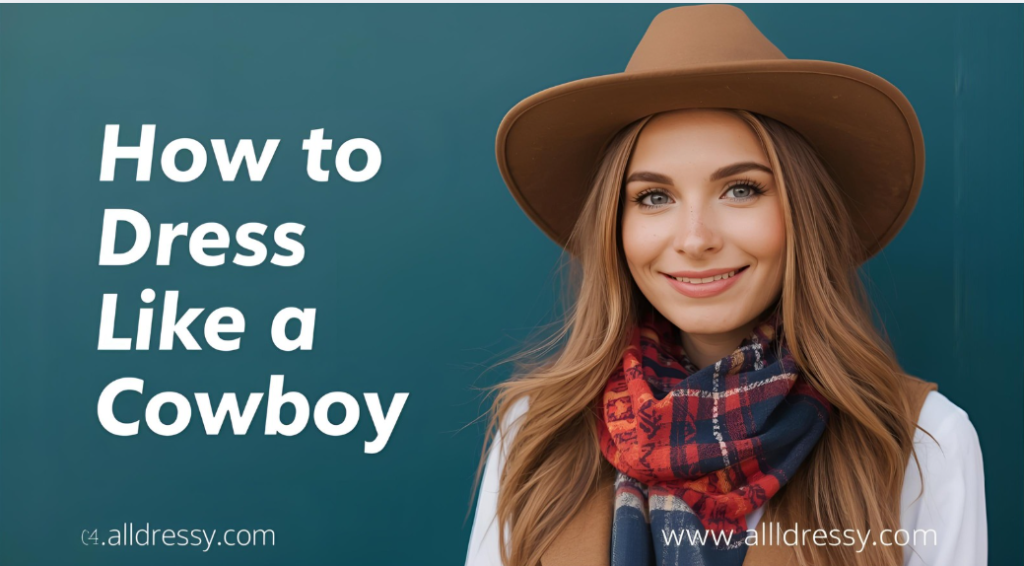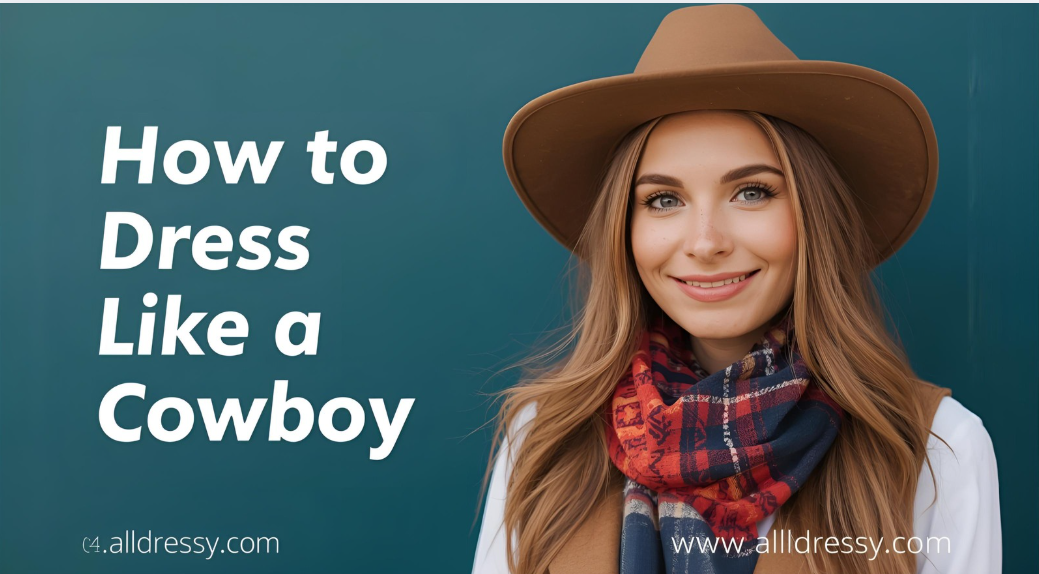Cowboy culture is deeply ingrained in American history and has inspired fashion worldwide. From rugged ranch work to rodeos and country-themed parties, knowing how to dress like a cowboy can help you capture the essence of this iconic style. Cowboy fashion is more than hats and boots—it’s about combining practicality, authenticity, and personal flair. Whether you’re aiming for a casual western look or a full-on rodeo-ready ensemble, this guide will cover every detail of cowboy attire, including clothing, accessories, footwear, and grooming tips.
Why Cowboy Fashion Is Timeless

Cowboy style is synonymous with resilience, freedom, and rugged elegance. Unlike fleeting fashion trends, cowboy attire is both functional and stylish. It evolved from the needs of cowhands and ranchers who required durable clothing while maintaining a recognizable aesthetic. Over time, the look transitioned from workwear to popular culture, influencing music, movies, and even high fashion.
Understanding how to dress like a cowboy allows you to pay homage to this culture while adapting it to modern fashion sensibilities. Cowboy style communicates confidence, individuality, and an adventurous spirit, making it perfect for casual wear, themed events, and even stylish streetwear.
Essential Cowboy Clothing
The cornerstone of cowboy attire is its practical yet stylish clothing. Here’s what every cowboy wardrobe should include:
1. Cowboy Hat
The cowboy hat is the most recognizable element of this look. It’s not just decorative—it offers sun protection, rain shielding, and even a tool for signaling on the ranch.
- Styles: The classic Stetson, wide-brimmed hats, or felt and straw options.
- Material: Felt for cooler weather and straw for summer.
- Fit: Should sit comfortably without sliding; avoid oversized or overly small hats.
2. Western Shirt
Western shirts distinguish cowboy fashion from ordinary casual wear. They feature unique patterns, snaps instead of buttons, and decorative yokes.
- Fabric: Cotton or denim for durability; flannel for warmth.
- Patterns: Plaid, solid colors, or embroidered designs.
- Details: Pearl snap buttons, piping, and embroidered motifs are classic western features.
3. Denim Jeans
Durable denim is essential. Jeans were originally designed for cowhands who needed tough pants that could withstand ranch work.
- Fit: Straight or relaxed fit is traditional; modern cowboys may prefer slim fits for a contemporary look.
- Wash: Medium to dark washes are versatile; faded denim adds a vintage touch.
- Details: Reinforced stitching and rivets enhance durability.
4. Cowboy Boots
Boots are a key statement piece. They combine functionality with distinctive style.
- Types: Riding boots, roper boots, or decorative western boots.
- Material: Leather is standard, but exotic options like snakeskin or ostrich exist for flair.
- Tips: Ensure a snug fit at the ankle with a comfortable sole for walking or riding.
5. Outerwear
Cowboy outerwear is practical yet stylish, especially for colder climates.
- Leather Jackets: Durable and versatile, perfect for casual or rugged appearances.
- Vests: Western vests add layering without bulk.
- Coats: Duster coats are iconic for dramatic flair and protection from dust.
Cowboy Accessories
Accessories complete the look and add authenticity to your outfit.
1. Belt and Buckle
A wide leather belt with a decorative buckle is a hallmark of cowboy style. Buckles often feature engraved designs, rodeo motifs, or silver detailing.
2. Bandanas
Originally used for dust protection, bandanas are versatile for style. Folded around the neck, tied to a hat, or worn as a pocket accent, they add color and personality.
3. Spurs and Chaps
While not necessary for casual wear, spurs and chaps are essential for rodeo or riding authenticity. Chaps protect the legs while riding, and spurs are functional for horseback control.
4. Jewelry
Subtle western-inspired jewelry, like leather bracelets, turquoise rings, or bolo ties, enhances the outfit without overwhelming it.
Choosing the Right Colors and Patterns
Cowboy style embraces earth tones and classic western patterns.
- Earthy Colors: Brown, tan, olive, and cream are traditional.
- Denim Blue: Jeans or jackets are central pieces.
- Plaids and Checks: Shirts often feature plaid patterns, adding visual interest.
- Accents: Red, turquoise, and muted yellows are common for accessories and bandanas.
Modern Adaptations of Cowboy Style
Cowboy fashion has evolved beyond the ranch. Modern cowboys blend traditional elements with contemporary trends:
- Slim-fit Jeans and Shirts: Contemporary cuts provide a cleaner silhouette.
- Minimalist Boots: Sleek leather boots for urban wear.
- Layering: Combining denim jackets with flannel shirts or t-shirts.
- Mixing Styles: Incorporating western hats or belts with casual streetwear.
How to Dress Like a Cowboy for Different Occasions
Casual Outings
- Fitted denim jeans, plaid western shirt, leather boots, and a straw cowboy hat.
- Optional accessories: leather belt with a simple buckle and a bandana.
Rodeos and Country Events
- Full western attire: embroidered western shirt, sturdy jeans, leather boots, and a felt cowboy hat.
- Add spurs, bolo tie, or vest for authenticity.
Night Out or Social Gatherings
- Modern cowboy: slim-fit jeans, minimalist boots, t-shirt or solid western-style shirt, leather jacket.
- Use accessories sparingly for a stylish urban cowboy look.
Work or Outdoor Ranch Activities
- Durable denim or canvas pants, long-sleeve cotton western shirt, sturdy leather boots.
- Wide-brimmed felt hat and bandana for sun protection.
Cowboy Grooming and Personal Style
A true cowboy look is not complete without grooming that matches the rugged, confident style.
- Facial Hair: Beards or mustaches are common, but must be well-groomed.
- Hair: Short, practical hairstyles or longer hair styled naturally.
- Skin Care: Outdoor cowboy activities require sun protection—sunscreen or moisturizer is key.
- Confidence: Cowboy style is about attitude. Stand tall and project self-assuredness.
Cowboy Fashion Mistakes to Avoid
- Wearing ill-fitting clothing: baggy or too-tight jeans ruin the silhouette.
- Over-accessorizing: too many jewelry pieces or flashy patterns clash with western aesthetics.
- Neglecting footwear: cheap sneakers undermine the cowboy look.
- Ignoring authenticity: overly modern or casual pieces without western elements may dilute the style.
- Poor grooming: unkempt facial hair or messy hair detracts from the rugged yet polished appearance.
Building a Cowboy Wardrobe
To master how to dress like a cowboy, start with versatile essentials:
- Hats: At least one felt and one straw hat.
- Shirts: Two to three western-style shirts in plaid, solid, or embroidered designs.
- Jeans: Two pairs of durable denim in different washes.
- Boots: One functional pair for work or outdoor events and one stylish pair for social occasions.
- Accessories: Leather belt with buckle, bandanas, and a bolo tie or subtle jewelry.
- Outerwear: Leather jacket, duster coat, or vest for layering.
Mixing and matching these pieces ensures you’re prepared for casual gatherings, rodeos, or country-themed events.
Cowboy Style in Popular Culture
Cowboy fashion has influenced movies, music, and even global streetwear:
- Movies: Classic Westerns set the standard for hats, boots, and rugged attire.
- Music: Country and folk musicians often incorporate cowboy style into performances and daily wear.
- Fashion Industry: Designers blend cowboy elements like boots, fringe jackets, and hats with modern trends.
Understanding the cultural significance adds authenticity when you adopt the cowboy look.
Tips for Comfort and Practicality
Cowboy attire is meant to be practical as well as stylish:
- Breathable Fabrics: Use cotton, denim, or wool to maintain comfort outdoors.
- Layering: Enables flexibility for changing temperatures.
- Footwear Comfort: Break in boots to prevent blisters.
- Hat Fit: Ensures protection from the sun while remaining comfortable.
Cowboy Attitude: The Finishing Touch
Ultimately, dressing like a cowboy is about confidence and presence. The right clothing and accessories are important, but your demeanor completes the look. Stand tall, move naturally, and embrace the rugged, adventurous spirit associated with cowboy culture. Whether at a country festival, casual gathering, or themed party, your attitude conveys authenticity.
Frequently Asked Questions (FAQs)
1. What are the essential items to dress like a cowboy?
The basics include a cowboy hat, western shirt, denim jeans, leather boots, and a belt with a statement buckle. Accessories like bandanas, bolo ties, and vests can enhance authenticity.
2. Can I dress like a cowboy without going overboard?
Yes, a modern cowboy look can be achieved by combining western elements like boots or a hat with casual or contemporary clothing, such as slim-fit jeans and a leather jacket.
3. What type of boots should I wear to emulate a cowboy?
Leather cowboy boots are essential. You can choose traditional riding boots, roper boots, or stylish western boots depending on the occasion and level of authenticity desired.
4. Are cowboy hats necessary for the look?
While not strictly required for casual interpretations, a cowboy hat is the most recognizable symbol of the style and instantly conveys authenticity, especially for themed events or rodeos.
5. How can I dress like a cowboy for modern social events?
Pair slim-fit jeans with a western shirt, leather boots, and minimal accessories like a leather belt or bandana. A leather jacket or vest adds a contemporary flair.
6. Can I incorporate colors or patterns into cowboy attire?
Yes. Earth tones like brown, tan, and olive are traditional, while plaid or embroidered shirts add classic western charm. Bandanas or subtle accessories can introduce brighter colors without overpowering the outfit.
7. How do I maintain cowboy clothing?
Regular leather care for boots and belts, washing denim as instructed, and proper hat storage ensures longevity. Avoid harsh cleaning methods that damage materials.
8. Is cowboy style appropriate for everyday wear?
Yes, elements like denim, boots, or western shirts can be incorporated into casual outfits, allowing a nod to cowboy style without full costume-like attire.
Conclusion
Mastering how to dress like a cowboy is about combining authenticity, practicality, and personal style. From the iconic cowboy hat to sturdy leather boots, each element contributes to a look that is rugged, confident, and timeless. Cowboy fashion balances functionality with flair, making it suitable for casual gatherings, rodeos, country-themed parties, or even modern streetwear interpretations.
Building a versatile cowboy wardrobe starts with the essentials: hats, shirts, jeans, boots, and key accessories. Layering and choosing appropriate fabrics ensure comfort and style across seasons. Attention to grooming, confidence, and presence completes the outfit, transforming clothing into a statement of personality and attitude.
By understanding the history, key pieces, and modern adaptations of cowboy style, you can confidently adopt this iconic look for any occasion, leaving a lasting impression that is both authentic and stylish.

